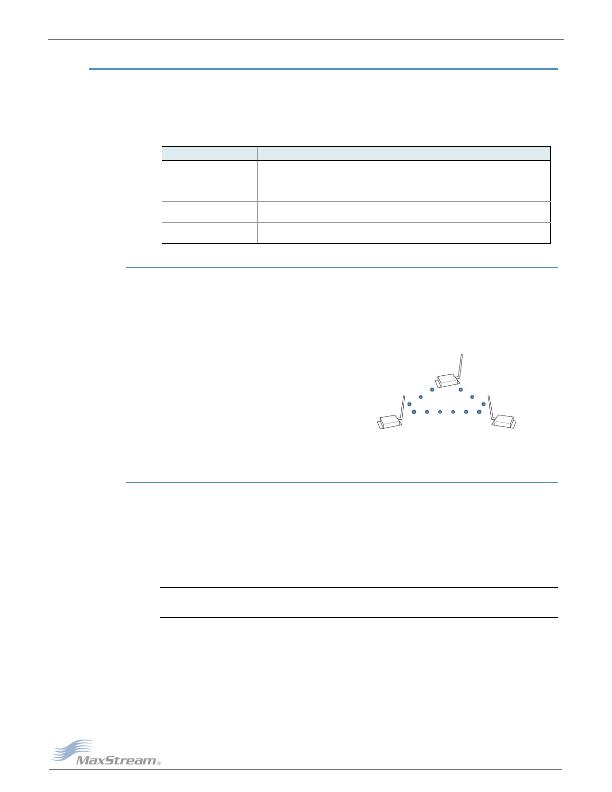- 您現(xiàn)在的位置:買賣IC網(wǎng) > Datasheet目錄58 > XBIB-U (Digi International/Maxstream)BOARD USB ZIGBEE MOD PRO Datasheet資料下載
參數(shù)資料
| 型號: | XBIB-U |
| 廠商: | Digi International/Maxstream |
| 文件頁數(shù): | 15/72頁 |
| 文件大小: | 1116K |
| 描述: | BOARD USB ZIGBEE MOD PRO |
| 設(shè)計(jì)資源: | XBIB-U Shematic |
| 標(biāo)準(zhǔn)包裝: | 1 |
| 附件類型: | 接口板 |
| 適用于相關(guān)產(chǎn)品: | XBee 和 XBee Pro 收音機(jī) |
第1頁第2頁第3頁第4頁第5頁第6頁第7頁第8頁第9頁第10頁第11頁第12頁第13頁第14頁當(dāng)前第15頁第16頁第17頁第18頁第19頁第20頁第21頁第22頁第23頁第24頁第25頁第26頁第27頁第28頁第29頁第30頁第31頁第32頁第33頁第34頁第35頁第36頁第37頁第38頁第39頁第40頁第41頁第42頁第43頁第44頁第45頁第46頁第47頁第48頁第49頁第50頁第51頁第52頁第53頁第54頁第55頁第56頁第57頁第58頁第59頁第60頁第61頁第62頁第63頁第64頁第65頁第66頁第67頁第68頁第69頁第70頁第71頁第72頁

XBee/XBeePRO"燨EM燫F燤odules??02.15.4?爒1.xAx燵2007.05.031]
2007燤axStream,營nc.
牋牋?5
Chapter??燫F燤odule燨peration
2.3. XBee/XBee-PRO Networks
The following IEEE 802.15.4 network types are supported by the XBee/XBee-PRO RF modules:
" NonBeacon
" NonBeacon (w/ Coordinator)
The following terms will be used to explicate the network operations:
2.3.1. NonBeacon
By default, XBee/XBee-PRO RF Modules are configured to support NonBeacon communications.
NonBeacon systems operate within a Peer-to-Peer network topology and therefore are not depen-
dent upon Master/Slave relationships. This means that modules remain synchronized without use
of master/server configurations and each module in the network shares both roles of master and
slave. MaxStream's peer-to-peer architecture features fast synchronization times and fast cold
start times. This default configuration accommodates a wide range of RF data applications.
Figure?06. NonBeacon燩eertoPeer燗rchitecture
A peer-to-peer network can be established by
configuring each module to operate as an End Device (CE = 0), disabling End Device Association
on all modules (A1 = 0) and setting ID and CH parameters to be identical across the network.
2.3.2. NonBeacon (w/ Coordinator)
A device is configured as a Coordinator by setting the CE (Coordinator Enable) parameter to
1
.
Coordinator power-up is governed by the A2 (Coordinator Association) parameter.
In a NonBeacon (w/ Coordinator) system, the Coordinator can be configured to use direct or indi-
rect transmissions. If the SP (Cyclic Sleep Period) parameter is set to
0
, the Coordinator will send
data immediately. Otherwise, the SP parameter determines the length of time the Coordinator will
retain the data before discarding it. Generally, SP (Cyclic Sleep Period) and ST (Time before Sleep)
parameters should be set to match the SP and ST settings of the End Devices.
Association plays a critical role in the implementation of a NonBeacon (w/ Coordinator) system. Refer
to the Association section [next page] for more information.
Table?02. Terms燼nd燿efinitions
Term
Definition
PAN
Personal Area Network - A data communication network that includes one or more End Devices and
optionally a Coordinator.
Coordinator
A Full-function device (FFD) that provides network synchronization by polling nodes [NonBeacon
(w/ Coordinator) networks only]
End Device
When in the same network as a Coordinator - RF modules that rely on a Coordinator for
synchronization and can be put into states of sleep for low-power applications.
Association
The establishment of membership between End Devices and a Coordinator. Association is only
applicable in NonBeacon (w/Coordinator) networks.
相關(guān)PDF資料 |
PDF描述 |
|---|---|
| XIB-E | BOARD INTERFACE ETHERNET |
| XIB-R | BOARD INTERFACE RS232/485 |
| ZMN2400HPDB | BOARD ROUTER DEV ZIGBEE 100MW |
| ZMN24HPDK-B | KIT DEV W/ZIGBEE ZMN2400HP |
| ZNI1000TC | IC TEMP SENSOR NI1000 SOT23-3 |
相關(guān)代理商/技術(shù)參數(shù) |
參數(shù)描述 |
|---|---|
| XBIB-U-DEV | 功能描述:界面開發(fā)工具 USB XBee-PRO profes onal interface board RoHS:否 制造商:Bourns 產(chǎn)品:Evaluation Boards 類型:RS-485 工具用于評估:ADM3485E 接口類型:RS-485 工作電源電壓:3.3 V |
| XBIB-U-SP | 功能描述:界面開發(fā)工具 USB/Xbee/Xbee-Pro Inf Brd SMT Pads RoHS:否 制造商:Bourns 產(chǎn)品:Evaluation Boards 類型:RS-485 工具用于評估:ADM3485E 接口類型:RS-485 工作電源電壓:3.3 V |
| XBIB-U-SS | 功能描述:界面開發(fā)工具 USB/Xbee/Xbee-Pro Inf Brd SMT Skt RoHS:否 制造商:Bourns 產(chǎn)品:Evaluation Boards 類型:RS-485 工具用于評估:ADM3485E 接口類型:RS-485 工作電源電壓:3.3 V |
| XBL6450BYFVR | 制造商:Texas Instruments 功能描述:ECS BLUELINK - Tape and Reel |
| XBL6450YFHR | 制造商:Texas Instruments 功能描述: |
發(fā)布緊急采購,3分鐘左右您將得到回復(fù)。